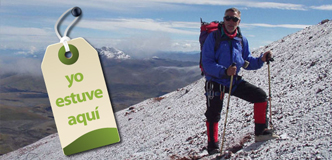 |
 |
|
|
| The Ecuadorian Amazon Jungle covers more than 1/3 of its territory |
|
|
|
 |
I was Here!!
Find out about Travelers experiences in Ecuador!!
|
|
|
|
| |
|
|
|
|
|
 /Travel in Ecuador /Travel in Ecuador / Andes/ /Travel in Ecuador /Travel in Ecuador / Andes/ |
|
|
| Ecuador and its 4 Worlds (Andes) |
|
|
infomundos
|
| |
|
|
| |
|
|
|
Andes (Sierra)
THE AVENUE OF THE VOLCANOES
Ecuador is straddled by the imposing Andean cordillera, running from north to south. Forming the country’s backbone and known as the Avenue of Volcanoes, these majestic mountains are enveloped by age-old glaciers and perpetual snows. At over five thousand meters above sea level, these peaks provide the perfect setting from which to admire the fertile inter Andean valleys, high mountain pampas and picturesque villages, cities and towns whose inhabitants, proud of their ancestral roots and traditions, welcome visitors with warm hospitality.
Ecuador’s Andean Region is the location of the world’s highest active volcano, the mythical Cotopaxi (5,897 meters above sea level) as well as the only snow-covered part of the equator, the Mt. Cayambe volcano at 5790 meters above sea level. The impressive Andean landscape never ceases to surprise. To the north of the region, the native “Polylepis” forest grows alongside the unique “frailejones”, a beautiful plant and symbol of the high Andean pampas.
The ancient cultures of Ecuador’s Andean Region (the “Sierra”) have acquired centuries of history and a plethora of rich and diverse traditions, typical foods, multihued handicrafts and colorful popular fiestas. From the largest cities to the smallest villages, a wealth of natural and cultural attractions will fascinate you.
Travel to and within Ecuador has improved immeasurably with recent airport developments, extended highway networks and an enlarged and enhanced infrastructure facilitating travel throughout the region and to other areas of the country. The Sierra is home to numerous colonial or early republican haciendas, many of which have been converted into comfortable lodgings. Forming part of Ecuador’s proud heritage, these Country Inns and Hostels are surrounded by gardens and set off against magnificent landscapes, enabling their guests to experience the countryside lifestyle.
|
|
| |
| |
Quito
TOUCHING THE SKY
The historic and centuries-old capital of Ecuador nestles within a long and narrow valley surrounded by imposing mountains, snow-covered peaks and smoldering volcanoes. Quito was the first city to be declared a UNESCO “World Cultural Heritage Site” in 1978 and its historic colonial center is recognized as being the largest and best preserved in Latin America. With an altitude of more than two thousand eight hundred meters, the current tourism slogan “Touch the Sky” reflects the sensation that by stretching out your hand you could feel the city’s bright blue sky. A short distance north of Quito lies Latitude 0°, the equator, where an interesting monument is the center-point of the “Middle of the World City” tourist complex |
|
|
|
|
| |
Otavalo
One and a half hours north of Quito is Otavalo, known throughout the world for its ancient and renowned Indian market, one of the most famous in South America. This is the place to seek out that original, varied and colorful handicraft you’ve always coveted. Stacked with a vast array of products from both Ecuador and other parts of Latin America, the most famous are the fine and multi-colored textiles woven by the skillful hands of the Otavaleño artisans and those from the surrounding villages of Peguche, San Antonio, Cotacachi and the “White City” of Ibarra, also the location of other superb handicraft centers. As its name suggests, the “Province of the Lakes” is the home of the wonderful lakes of San Pablo, Cuicocha and Yaguarcocha. |
|
|
|
|
| |
AVENUE OF THE VOLCANOES
A particular apposite name given by the German naturalist Alexander Von Humboldt to this sector of the Ecuadorian Andes where dozens of immense volcanoes form a natural Boulevard or Avenue overlooking the central valleys. Looming up on both sides of the road, the mighty snow-covered colossuses of Cayambe, Antisana, Cotopaxi, Chimborazo, Tungurahua and others provide the traveler with stunning views, many of which act as permanent companions for those exploring the region. Set among rich and brightly colored cultivated fields, reflecting various hues of green and gold against a backdrop of quaint yet fascinating towns, this is the ideal venue for a variety of activities such as mountain trekking, horseback riding and many others situated amidst a natural beauty that you will never forget. |
|
|
|
|
| |
THE DEVIL’S NOSE
The historic Trans Andean railway of Ecuador, inaugurated in 1908, still rides the tracks along several sectors of the Andean Region. Undoubtedly the most famous stretch is the “Devil’s Nose”, an outstanding feat of early 20th century engineering incorporating an ingenious zigzag system that enables trains to descend more than 300 hundred meters of a steep rock wall. The adventure starts in Riobamba, in the center of the Andes, located at the foothills of the spectacular and immense Mt. Chimborazo. Passing a number of glorious sights, scenes and ecosystems, the train weaves its way through picturesque villages such as Guamote and Alausí before descending the Devil’s Nose, an experience that can only be described as breathtaking.
|
|
|
|
|
| |
CUENCA AND EL CAJAS
A Colonial City and Mystical lakes
Lying among the southern Ecuadorian Andes is Cuenca, a city also declared by UNESCO as a World Cultural Heritage Site. Considered an architectural jewel for its well-preserved colonial center, Cuenca is a living museum of traditional architecture. Its narrow streets and charming houses are adorned by flowerpot-covered balconies, while the splendid churches, convents, monasteries, beautiful plazas and monuments give the city an aura of times gone by. Cuenca is also a renowned for producing some of Ecuador’s finest handicrafts.
A short distance from Cuenca is El Cajas National Park, a truly mystical mountain enclave where a remarkable complex of hundreds of lagoons, half concealed between small valleys and rocky cliffs, form the perfect place to admire nature’s magnificence and to practice activities such as trekking, nature walks, horse back riding, trout fishing and more.
|
|
|
|
|
|
|
|
|
|
|
|
|
|